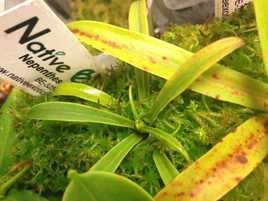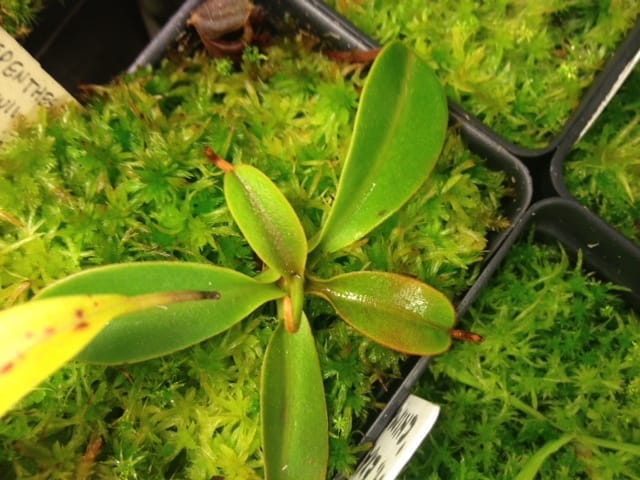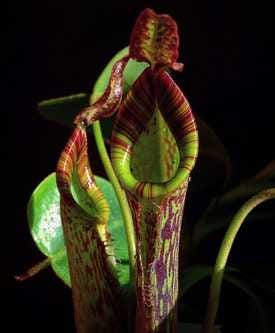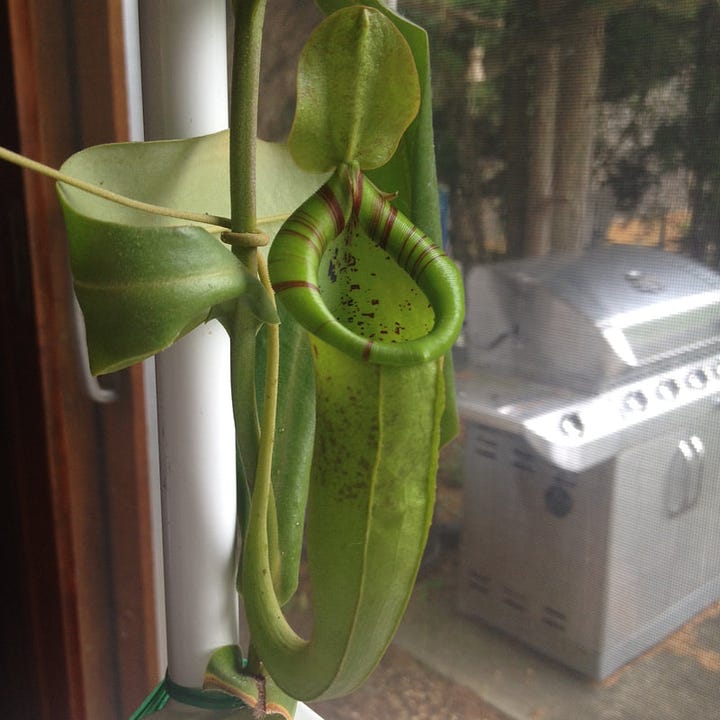GROWING HIGHLAND NEPENTHES
The majority of Nepenthes species are classified as highlanders (I am also including the so-called "intermediate" species, which I will group here in order to simplify things). Since these plants originate from higher elevations, they generally require cooler temperatures in order to thrive, around the order of 75F during the day and 55F at night (like with lowlanders, these numbers vary greatly by species; ultra-highlanders require cooler temperatures while species that grow nearer to the 1000m mark are more forgiving of high temperatures). Since I don't have the fortune of having a greenhouse to grow all of my plants in, when I typically acquire plants, I sort them on the basis of whether they will require the climate - controlled environment of my highland terrarium or will be able to grow in my windowsill setup. I will discuss the culture of these two groups separately below.

Introduction
Or in the other words, the species that I like to consider "obligate highlanders" - species that absolutely require the high humidity, cool temperatures, and nighttime temperature drop that I can only provide in a closed, controlled tank (yes, I know that people can grow some of these species on windowsills or outside in coastal California, but not all of us live in coastal California). These are most often the most coveted and expensive plants in the genus, including the species prized for having "toothy" peristomes, species that I like to call the "toilet bowl" complex, and other rarities. Classic examples include toothies such as N. hamata (yes, I do know that there is a clone(s?) floating around that can be grown as a houseplant), N. macrophylla, N. edwardsiana, N. villosa and etc., toilet bowl plants like N. jamban and N. jacquelineae, and other oddballs like N. glabrata, N. dubia and N. inermis, N. lowii, N. lingulata, etc. The list is quite extensive, really. Most of these species (with exceptions, of course) prefer very bright light. That's fine and dandy, but an issue arises when attempts to give enough light result in the temperature rising to unacceptable levels.
Temperature
These plants expect balmy daytime temperatures of around 70-75F and a nighttime drop to around 55F, and depending on the species, having varying degrees of tolerance for temperatures outside of this range. (As always, these numbers vary by species - ultrahighlanders will likely require cooler temperatures to thrive in the long term.) My plants experience these temperatures for about 9 months of the year, but during the summer the day temperatures usually hover around 80-85F. The plants are not thrilled, but since I can drop the night temperatures to around 60F during the hottest summer months, they remain in reasonable health until the arrival of winter. If the daytime temperatures are to be elevated, dropping the temperature at night is crucial - take a look at what happened when I left some of my plants without a nighttime drop for 2 weeks while I was on vacation.




The horrors! Given proper temperatures, most of these plants will take months to resume normal growth, let alone regain their former size. Ye be warned - give these plants the temperatures they want or they will slowly shrink into oblivion and taunt your conscience with the knowledge that you are responsible for their torturous and slow decline.
Humidity,Watering, and Media
In better news, the other aspects of the cultivation of these plants are pretty easy to meet once the temperature issue is taken care of. They require high humidity (especially at night), which is easily achieved by growing them in an enclosed space (although make sure you have some air circulation in there as well). Water should be low in TDS as with all other carnivorous plants (they can be fertilized with dilute orchid food though, which I will get into later) and the media should be kept airy, moist, and acidic. Most of these plants appreciate mixes based on high quality long-fibered Sphagnum mixed in with varying proportions of aerating material like perlite, bark, salt-free coco husk, or kanuma with a little bit of peat mixed in as well. Live Sphagnum is also fantastic as media if you have enough of it - many of the highland species from Sulawesi seem particularly fond of it. If you don't have enough live Sphagnum to put the plants in, a top dressing is also aesthetically pleasing and helps with ambient humidity. The plants will want to be repotted once the media starts breaking down and turning anaerobic, but if you use good quality ingredients and formulate your mix to perform well in your conditions this should only be required every few years or so. Most highland species tend to hate root disturbance so make your soil mix to last!
A note about soil mixes - there is no univeral "ideal" mix and the components that successful growers use vary based upon the species, what their conditions are, and what is available to them. Finding the right mix for you will likely require some experimentation.
Species Suitable for the Windowsill
Most of the species that I have placed into this category tend to skew more towards intermediate than true highland elevations. In nature they generally experience daytime temperatures of 75-80F with a nighttime drop to 60-65F, although like always, these numbers will vary slightly depending on the species and the locality. In my mind, I include most species of the N. maxima complex such as N. fusca, N. boschiana, N. stenophylla, and N. vogelii, species with thick leaves like N. truncata and N. robcantleyi, and others like N. ventricosa and N. sanguinea and their hybrids on the "potential windowsill growers" list. Weedy mass-produced commercial hybrids like N. x ventrata and N. 'Miranda' are also included here, but that really should go without saying.



Most of these species generally enjoy being treated like the highlanders mentioned above but with slightly warmer temperatures, but the great thing about these species is that in most cases they are far more forgiving in terms of humidity and nighttime temperature drops. I grow several of the above mentioned species and associated hybrids in front of a south-facing patio door which typically gets around 40-50% RH during the summer and 25% RH maximum during the winter. Temperatures in direct sunlight during the summer reach up to 85F with only a drop to around 75F at night, while wintertime temperatures are usually 70F during the day and 63-65F at night. (The plants I keep in these conditions have been growing well and increaing in size quickly for over a year, so I am confident that the plants will not suddenly decline due to the lack of adequate temperature drops.) Since the pots do tend to dry out more quickly, I use a slightly heavier Sphagnum/perlite mix with more Sphagnum on my windowsill plants (no live Sphagnum of course due to the poor humidity) that doesn't require watering every day - the proportions will likely need to be adjusted based on your conditions.
I've found that the critical factor affecting pitcher production on the windowsill is light. For this reason, the plants tend to put out less pitchers during the darker winter months. Growing on a south or east-facing windowsill is ideal to allow the plants to receive the hours of both direct and indirect sunlight that they need to produce pitchers; even with higher humidity, the plants will refuse to pitcher without adequate light. Ideally I would supplement my plants with artificial light during the winter months but unfortunately my setup is not conducive to that. I tried misting my plants regularly during a period but did not notice any significant difference in growth - I imagine that the short period of time the relative humidity is raised due to misting has a negligible impact on the plants and may even hinder the process of acclimation to lower humidity.


All of this does not mean that a windowsill is always the best place to grow these species though! All Nepenthes perform better (or at least equally as well) when all the conditions of their habitat are being met - for the windowsill, humidity and textbook temperature drops are the deficient factors. These species are simply among those which, when more vital needs such as sufficient light are being met, are able to perform satisfactorily on the windowsill in the long-term in spite of the lower humidity. My windowsill plants take time ranging from several weeks to several months to over a year to develop a thick cuticle and acclimate to the lower humidity before producing pitchers; once established however, they tend to be strong and reliable growers. If you're limited on space, certainly, windowsill growing is a viable option for many fine Nepenthes.
Notes About Fertilization
I fertilize all of my Nepenthes with a urea-free liquid orchid fertilizer poured directly into the media monthly during the winter months and biweekly in the summer, alternating with regular watering (or in reality I attempt to, I forget most of the time and just end up fertilizing when I feel that the plants have gone on long enough without fertilizer). Nepenthes are far more tolerant of nutrients in their soil than other CPs like Drosera or Dionaea and can really benefit from the extra nutrients, often responding with more robust growth and leaf jumps. It is important to not overdo the fertilizer - I use a 100ppm solution, but 1/4 the strength described on the package should also be safe. I do not flush the pots beyond regular watering and have never had any issues relating to fertilizer build-up in the soil. I use the same fertilizer regimen for Heliamphora and Drosera regia.
Other valid methods of fertilization include placing insects, fish food pellets, or fertilizer pellets like Osmocote directly in active pitchers, or placing Osmocote in the soil. I have not seen convincing evidence that applying fertilizer via a foliar spray does anything significant for the plants (all support that I've seen for this notion seems to consist of anecdotal evidence that the plants grew "faster" or "larger" as a direct result of fertilization - until someone publishes results of this with a control group I am not convinced).




